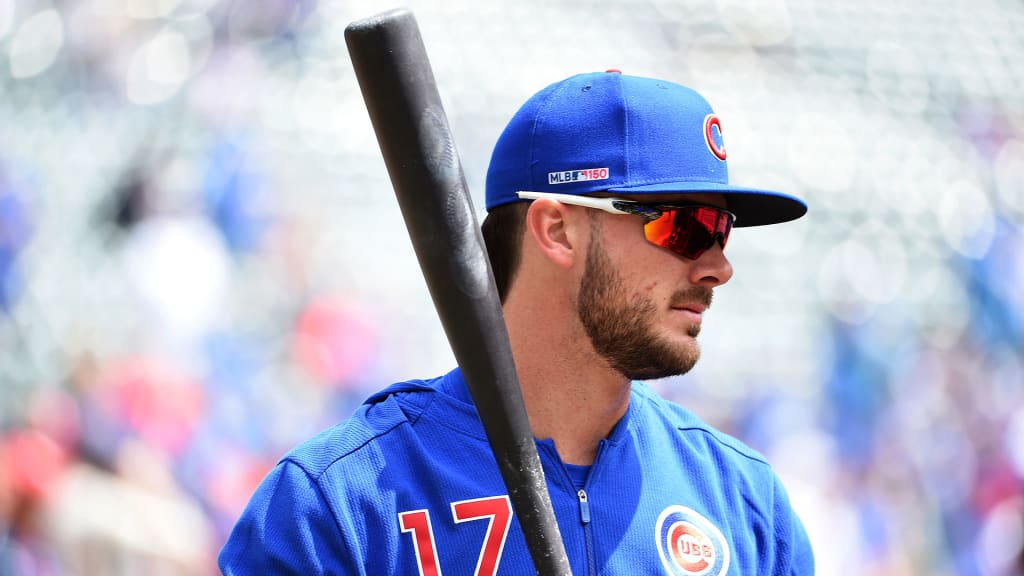
Drawing any kind of sweeping conclusions after only four games would be inappropriate given the ebbs and flows of a six-month baseball season. Whether looking at good developments or poor performances on a diamond, it just is not fair to dive too deeply into trying to forecast the path a team will take between now and October.
Given the way the first few games have gone for the Cubs, however, and considering the high expectations placed on the team in this year of "reckoning," the temptation to overreact is strong.
"It's game four," Cubs starter Kyle Hendricks reminded reporters Monday night.
OK, so there is still 98 percent of the regular season left to play. There is no reason to panic, even if that is part of the DNA of some fans. Instead of looking up to see if any pieces of the sky are falling, let's run through a handful of positives and concerns that have shown up in Chicago's first four games.
THREE UP
1. Kris Bryant's left shoulder
According to Statcast, Bryant has posted an average exit velocity of 90.6 mph through the Cubs' first few games. That is noteworthy because of Bryant's lack of power over the final four-plus months last year. From May 19 (when Bryant injured his left shoulder) through the rest of the 2018 season, he had an average exit velocity of 83.6 mph. During his National League MVP campaign in '16, he posted an 89.3 average EV for the entire season. The third baseman is healthy and the peripheral numbers are already backing up the on-field results.
2. Kyle Schwarber's new, old stance
Schwarber arrived to camp this spring with a more crouched stance, which was a return to some of the mechanics he displayed early in his pro career. During Spring Training, the slugger showed off a solid opposite-field approach, and that has carried into the season. Now, Schwarber's 50 percent opposite-field rate is not sustainable (he has a 23.8 percent rate for his MLB career), but it sheds some light into a potentially improved approach stemming from an adjusted stance. He already has two home runs: One to left-center and one to right-center.
3. The offense's overall approach
The Cubs' lineup did not produce Monday night (no runs, 0-for-8 with runners in scoring position and 10 stranded), but the offense overall has been a positive so far. Chicago entered Tuesday's off-day with a .327/.415/.524 slash line, with nearly as many walks (22) as strikeouts (26). Only the Pirates (+3) had a smaller difference than the Cubs (+4) between walks and strikeouts. Chicago's 89.6 percent contact rate in the zone leads the NL, while it ranks third in overall contact rate (80.1 percent) and fifth-best in chase rate (swings at pitches outside the zone) at 26.8 percent.
THREE DOWN
1. Carl Edwards Jr.'s new delivery
Over the offseason, Edwards worked on a new delivery method. He studied a hesitation move used at times by Kenley Jansen and debuted his own version of it in camp with the Cubs. Edwards would lift his left leg, pause after lowering it and then drive forward. There was sometimes a quick toe tap involved. The goal was more balance and better command. By Edwards' season debut, though, the pause evolved into full stop, with his foot re-planted on the mound. MLB informed the Cubs that the stop was illegal due to it technically resulting in two steps to the plate. On Monday, Edwards abandoned the move, which had contributed to a strong spring showing (eight strikeouts and no walks in six innings).
2. The bullpen
With the disclaimer that 15 1/3 innings is not enough to declare a bullpen good or bad, the Cubs knew coming into the 2019 season that the relief corps was an area of need. The biggest addition was Brad Brach, which added another experienced late-inning arm to the fold, but Chicago sat out on the bidding for big-ticket relievers over the winter due to budget restrictions. Craig Kimbrel is still a free agent, but the Cubs have made it clear that their monetary approach is unlikely to change at this point. Through four games, Chicago's bullpen has turned in a 7.63 ERA with a 1.96 WHIP and 16.4 percent walk rate.
3. The defense
The Cubs' defense should be strong by season's end and it looked great during the first three games in Texas. Monday night will probably wind up being an anomaly, especially since the Cubs had not previously made six errors in a nine-inning game since 1982. It's still worth putting the defense in this section, because of how crucial that aspect of the team will be to Chicago's success this year. With an older rotation and a ball-in-play bullpen, the Cubs need the defense to be clicking to maximize production on the pitching side. In what should be a tight division race, the team can ill afford to have more nights like Monday in Atlanta.


